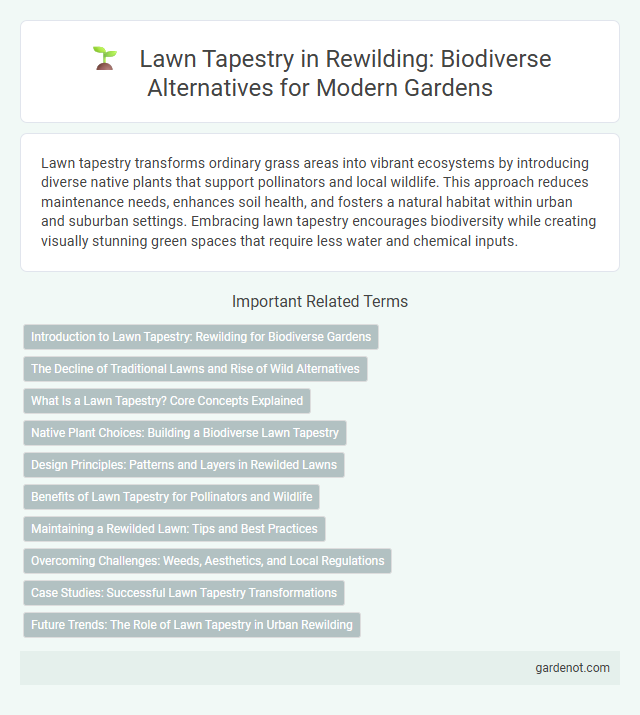Lawn tapestry transforms ordinary grass areas into vibrant ecosystems by introducing diverse native plants that support pollinators and local wildlife. This approach reduces maintenance needs, enhances soil health, and fosters a natural habitat within urban and suburban settings. Embracing lawn tapestry encourages biodiversity while creating visually stunning green spaces that require less water and chemical inputs.
Introduction to Lawn Tapestry: Rewilding for Biodiverse Gardens
Lawn tapestry transforms traditional grass lawns into biodiverse habitats by integrating native wildflowers, grasses, and pollinator-friendly plants, fostering ecosystem resilience. This rewilding approach supports beneficial insects, birds, and soil health, creating a dynamic garden environment that thrives with minimal maintenance. Emphasizing local species enhances habitat connectivity and promotes sustainable urban biodiversity.
The Decline of Traditional Lawns and Rise of Wild Alternatives
The decline of traditional lawns stems from increased awareness of their environmental costs, including high water usage, chemical fertilizers, and limited biodiversity. Wild alternatives such as native plant meadows and wildflower tapestries promote ecological balance by supporting pollinators, improving soil health, and reducing maintenance needs. This shift toward natural landscapes enhances urban ecosystems and fosters resilient habitats in residential and public spaces.
What Is a Lawn Tapestry? Core Concepts Explained
A lawn tapestry is a natural landscaping approach that replaces traditional monoculture grass lawns with diverse plant species, enhancing biodiversity and ecosystem health. This method integrates native wildflowers, grasses, and groundcovers to create visually appealing, low-maintenance outdoor spaces that support pollinators and improve soil quality. Lawn tapestry promotes sustainable land use by fostering resilient habitats and reducing the need for synthetic fertilizers and frequent mowing.
Native Plant Choices: Building a Biodiverse Lawn Tapestry
Selecting native plant species such as Black-eyed Susans, Purple Coneflowers, and Little Bluestem creates a biodiverse lawn tapestry that supports local wildlife and promotes soil health. Incorporating a variety of native grasses, wildflowers, and groundcovers enhances habitat complexity and resilience against pests and diseases. This approach reduces maintenance needs and water consumption while fostering a thriving ecosystem integral to regional biodiversity.
Design Principles: Patterns and Layers in Rewilded Lawns
Patterns and layers in rewilded lawns create dynamic habitats by combining diverse plant species that mimic natural ecosystems. Incorporating native grasses, wildflowers, and groundcovers establishes textural contrasts and seasonal color variations, fostering biodiversity and soil health. Thoughtful layering enhances ecological function while producing visually appealing, sustainable lawn tapestries that support pollinators and wildlife.
Benefits of Lawn Tapestry for Pollinators and Wildlife
Lawn tapestry enhances biodiversity by providing diverse flowering plants that supply essential nectar and pollen for pollinators like bees and butterflies. This varied habitat supports a wide range of wildlife, including beneficial insects, birds, and small mammals, promoting ecosystem resilience. Creating lawn tapestry reduces the need for chemical pesticides and fertilizers, fostering a healthier environment for native species and improving soil quality.
Maintaining a Rewilded Lawn: Tips and Best Practices
Maintaining a rewilded lawn requires regular monitoring of native plant growth and selective trimming to promote biodiversity while preventing invasive species proliferation. Employing organic mulches and natural fertilizers enhances soil health and supports pollinators vital to ecosystem balance. Integrating adaptive watering techniques aligned with local climate conditions conserves water resources and sustains native flora vitality.
Overcoming Challenges: Weeds, Aesthetics, and Local Regulations
Effective rewilding with lawn tapestry requires managing invasive weeds through selective planting of native species that outcompete unwanted plants, enhancing biodiversity. Addressing aesthetic concerns involves designing with varied textures and seasonal colors to create visually appealing, natural landscapes that challenge traditional lawn expectations. Navigating local regulations demands coordination with municipal guidelines to ensure compliance while promoting habitat restoration and ecological resilience.
Case Studies: Successful Lawn Tapestry Transformations
Lawn tapestry projects in urban and suburban areas have demonstrated significant ecological benefits by increasing native plant diversity and supporting pollinator populations. Case studies such as the transformation of Chicago's Northerly Island and the restoration of the High Line in New York City showcase how integrating native grasses and wildflowers can create resilient, low-maintenance landscapes. These successful examples highlight how lawn tapestry designs enhance biodiversity, reduce water use, and improve soil health.
Future Trends: The Role of Lawn Tapestry in Urban Rewilding
Lawn tapestry, a low-maintenance ground cover combining native wildflowers and grasses, is increasingly integral to urban rewilding projects aimed at enhancing biodiversity. Future trends indicate a shift towards using lawn tapestry to create pollinator-friendly habitats that improve ecosystem health in cities while reducing the need for irrigation and chemical inputs. Innovative designs are also expected to integrate smart irrigation systems and drought-resistant species, promoting sustainable green spaces that support urban wildlife corridors.
Lawn tapestry Infographic

 gardenot.com
gardenot.com